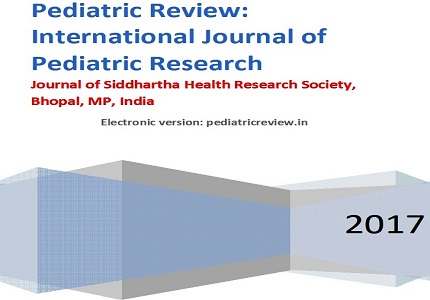Perfusion index and Plethysmographic variability index values in spontaneously breathing clinically stable term neonates in room air in the first 10 days of life
Abstract
Background: Perfusion index (PI) and Pleth Variability Index (PVI) are newer pulseoximeter derived numerical non-invasive measures of Peripheral perfusion. PI gives real time changes in peripheral blood flow and PVI the dynamic changes in the PI that occur during the respiratory cycle. Reference values for neonatal population are very few and not yet published for Indian neonates. We undertook this study to establish the reference values for the first 10 days of life in term neonates.
Methods: Prospective analytical study conducted at Division of Neonatology, Government Rajaji Hospital, Madurai Medical College. Inborn term neonates, spontaneously breathing in room air and clinically stable, without respiratory distress, on direct breast feeds or oral feeds are eligible for the study. PI, PVI values are recorded on the foot of neonates using Masimo Pulse oximeter for 15 minutes and data transferred to a computer and analyzed.
Results: The Primary outcome median value of perfusion index is 1.4 IQR (1.0, 2.0) and Pleth variability index is 19.0 IQR (15.0, 25.0).
Conclusions: The reference ranges for perfusion index and pleth variability index in healthy term Indian neonates are presented.
Downloads
References
2. Corp M. Technical Bulletin Pleth Varibility Index [Internet]. White Papers. [cited 2017July21]. Available from: http://www.masimo.com/de/Home/clinical-evidence/white-papers/
3. Lima AP, Beelen P, Bakker J. Use of a peripheral perfusion index derived from the pulse oximetry signal as a noninvasive indicator of perfusion. Crit Care Med. 2002 Jun;30(6):1210-3.
4. Zaramella P, Freato F, Quaresima V, Ferrari M, Vianello A, Giongo D, Conte L, Chiandetti L. Foot pulse oximeter perfusion index correlates with calf muscle perfusion measured by near-infrared spectroscopy in healthy neonates. J Perinatol. 2005 Jun;25(6):417-22. [PubMed]
5. Latini G, Dipaola L, De Felice C. First day of life reference values for pleth variability index in spontaneously breathing term newborns. Neonatology. 2012;101(3):179-82. doi: 10.1159/000331774. Epub 2011 Oct 22.
6. De Felice C, Latini G, Vacca P, Kopotic RJ. The pulse oximeter perfusion index as a predictor for high illness severity in neonates. Eur J Pediatr. 2002 Oct;161(10):561-2. Epub 2002 Sep 3.
7. Chu H, Wang Y, Sun Y, Wang G. Accuracy of pleth variability index to predict fluid responsiveness in mechanically ventilated patients: a systematic review and meta-analysis. J Clin Monit Comput. 2016 Jun;30(3):265-74. doi: 10.1007/s10877-015-9742-3. Epub 2015 Aug 5.
8. Jardim J, Rocha R, Silva G, Guimarães H. Peripheral perfusion index-reference range in healthy Portuguese term newborns. J Pediatr Neonat Individual Med. 2014;3(1):e030109. doi: 10.7363/030109
9. Hakan N, Dilli D, Zenciroglu A, Aydin M, Okumus N. Reference values of perfusion indices in hemodynamically stable newborns during the early neonatal period. Eur J Pediatr. 2014 May;173(5):597-602. doi: 10.1007/s00431-013-2224-z. Epub 2013 Dec 3.
10. Kroese JK, van Vonderen JJ, Narayen IC, Walther FJ, Hooper S, te Pas AB. The perfusion index of healthy term infants during transition at birth. Eur J Pediatr. 2016 Apr;175(4):475-9. doi: 10.1007/s00431-015-2650-1. Epub 2015 Oct 24.
11. Kinoshita M, Hawkes CP, Ryan CA, Dempsey EM. Perfusion index in the very preterm infant. Acta Paediatr. 2013 Sep;102(9):e398-401. doi: 10.1111/apa.12322. [PubMed]
12. Granelli Ad, Ostman-Smith I. Noninvasive peripheral perfusion index as a possible tool for screening for critical left heart obstruction. Acta Paediatr. 2007 Oct;96(10):1455-9. Epub 2007 Aug 28. PubMed PMID: 17727691.
13. Vidal M, Ferragu F, Durand S, Baleine J, Batista-Novais AR, Cambonie G. Perfusion index and its dynamic changes in preterm neonates with patent ductus arteriosus. Acta Paediatr. 2013 Apr;102(4):373-8. doi: 10.1111/apa.12130. Epub 2013 Jan 19.
14. Bagci S, Müller N, Müller A, Heydweiller A, Bartmann P, Franz AR. A pilot study of the pleth variability index as an indicator of volume-responsive hypotension in newborn infants during surgery. J Anesth. 2013 Apr;27(2):192-8. doi: 10.1007/s00540-012-1511-6. Epub 2012 Nov 7. PubMed PMID: 23132180.
15. Bahlmann H, Hahn RG, Nilsson L. Agreement between Pleth Variability Index and oesophageal Doppler to predict fluid responsiveness. Acta Anaesthesiol Scand. 2016 Feb;60(2):183-92. doi: 10.1111/aas.12632. Epub 2015 Sep 16. [PubMed]

Copyright (c) 2017 Author (s). Published by Siddharth Health Research and Social Welfare Society

This work is licensed under a Creative Commons Attribution 4.0 International License.


 OAI - Open Archives Initiative
OAI - Open Archives Initiative


